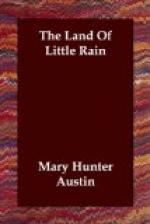It is enough occupation, when no storm is brewing, to watch the cloud currents and the chambers of the sky. From Kearsarge, say, you look over Inyo and find pink soft cloud masses asleep on the level desert air; south of you hurries a white troop late to some gathering of their kind at the back of Oppapago; nosing the foot of Waban, a woolly mist creeps south. In the clean, smooth paths of the middle sky and highest up in air, drift, unshepherded, small flocks ranging contrarily. You will find the proper names of these things in the reports of the Weather Bureau—cirrus, cumulus, and the like—and charts that will teach by study when to sow and take up crops. It is astonishing the trouble men will be at to find out when to plant potatoes, and gloze over the eternal meaning of the skies. You have to beat out for yourself many mornings on the windly headlands the sense of the fact that you get the same rainbow in the cloud drift over Waban and the spray of your garden hose. And not necessarily then do you live up to it.
THE LITTLE TOWN OF THE GRAPE VINES
There are still some places in the west where the quails cry “cuidado”; where all the speech is soft, all the manners gentle; where all the dishes have chile in them, and they make more of the Sixteenth of September than they do of the Fourth of July. I mean in particular El Pueblo de Las Uvas. Where it lies, how to come at it, you will not get from me; rather would I show you the heron’s nest in the tulares. It has a peak behind it, glinting above the tamarack pines, above a breaker of ruddy hills that have a long slope valley-wards and the shoreward steep of waves toward the Sierras.




